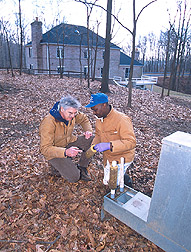This page has been archived and is being provided for reference purposes only. The page is no longer being updated, and therefore, links on the page may be invalid.
|
Read: a full report of the project. |
Deer Feed, Ticks Drop in Maryland Control ProgramBy Judy McBrideMay 25, 2001 Ticks that transmit Lyme disease have been dropping like flies in parts of Maryland where deer snack on corn in pesticide-treated feeders developed by Agricultural Research Service scientists in Kerrville, Texas. To reach the corn, deer brush their heads and necks against paint rollers filled with amitraz--an acaricide deadly to ticks but relatively harmless to beneficial insects and wildlife. Maryland is one of five northeastern states involved in a project to test these feeders. ARS entomologist John F. Carroll at the Henry A. Wallace Beltsville (Md.) Agricultural Research Center and the other project researchers in Connecticut, Rhode Island, New York and New Jersey aim to reduce blacklegged tick nymphs at each of the 1,280-acre treatment sites by 90 percent after five years. It’s the tick’s tiny, nymph stage that transmits the Lyme disease bacterium to most people. In 2000, two years after the feeders were deployed at three Maryland test sites, blacklegged tick nymphs had dropped 59 to 71 percent, according to Carroll. He anticipates reductions of at least 75 percent after two more years. In the Northeast, the blacklegged tick has a two-year life cycle. While tick nymphs are most dangerous to humans, the four-poster feeder targets female adults--before they can lay the eggs that will hatch into larvae that develop into nymphs. A female tick can lay up to 3,000 eggs in her lifetime but rarely passes on the Lyme disease pathogen to her offspring. Generally, the larvae--before they become nymphs--pick up the pathogen from feeding on infected mice or other small animals. In the spring of 1998, Carroll and colleagues set out 25 feeders at the Beltsville center and at each of two other sites located near Baltimore where deer and tick populations are high. The researchers keep the feeders stocked with corn and amitraz in spring and fall, when adult blacklegged ticks look for a blood meal. Nearly all female ticks feed on deer. ARS is the U.S. Department of Agriculture’s chief scientific research agency. Scientific contact: John F. Carroll, ARS Parasite Biology, Epidemiology and Systematics Laboratory, Beltsville, Md., phone (301) 504-9017, fax (301) 504-5306, jcarroll@anri.barc.usda.gov. |

